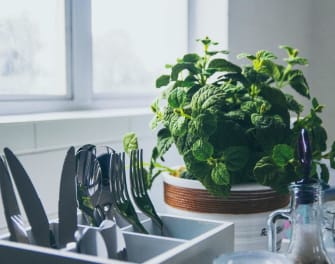Are you here because you're thinking about bringing some plants into the house but you're worried they'll all turn into unrecognizable shriveled strings within days? Don't worry we've all been there.

The truth is, even the person with the "greenest thumb" has killed a plant or two and what they're probably not telling you is that's how they learned to grow plants so well. And just because you haven't been good at taking care of plants before doesn't mean you can't start now.
All it takes is some good research (which you're doing now), patience, and practice.
In this article, we're going to teach you all the basics of decorating with plants. We're going to help you pick the best plants for your house according to the amount of sunlight it gets, how much time you have for them, and the look that you want.
Get ready to learn more and see how you can enjoy decorating with houseplants.
Placement of Plant
The amount of sunlight your home receives is the most important factor when decorating with houseplants. And the biggest mistake that most people make is they treat every room and every corner of their house the same.
Before you run off to your plant nursery and dropping a fortune on plants, take a look around and make mental notes of how much sunlight each room gets and where you would like to place the plants.
Putting a plant that loves sunlight in a dark corner or a plant that fears sunlight right in front of a window won't do it any good. Think of it this way: plants have personalities. They all like different things and you need to treat them as such.
Sun-Loving Plants
Succulents and cacti have become wildly popular in the last few years due to their unique appearances, small sizes, and relatively low-maintenance. If you choose them, make sure you place them in an area with lots of sunlight and DO NOT over water them! Succulents and cacti only need a spritz once a week or less depending on where you live.
If you enjoy more interactions with your plants, try planting Geraniums or Umbrella plants instead. Geraniums are flowering plants that originate from the Mediterranean and they can handle lots of sun and more humidity than succulents and cacti. Umbrella plants are great space fillers because they can grow up to several feet tall (unless you have the dwarf varieties).
The general rule of them for all sun-loving plants is to avoid overwatering and never leave them sitting in a base of water because their roots will rot.
Medium Sunlight Plants
If your house gets a medium amount of sunlight (receives only a few hours of sunlight or mostly indirect sunlight) you're better off with plants like Begonias, African violets, or Areca Palm. They thrive in short periods of direct sunlight or in partial shade when planted indoors.
Begonias are flowering plants that come in all shapes, colors, and sizes and do well all year round. African violets are a bit more delicate in that they need room-water temperature but if you have the patience, they'll bloom in gorgeous snowy shades of purple. Areca Palm is a good choice for decorating if you want something green and vibrant to liven up space without too much noise.
Most medium sunlight plants require moist soil. You have to water them consistently (perfect for those of you who like to "talk" to your plants).
But at the same time, don't over do it because they'll need periods of time in between for the roots to dry.
Low-Light Plants
If you wish to decorate a room or area that receives very little light with plants (meaning you must turn on the lights to see), you will need low-light plants. But don't worry. There are plenty of options to choose from.
Believe it or not-some plants are actually afraid of getting too much sun because it damages their leaves. The Spider Plant, Rattlesnake Plant, Elephant's Ear, Lucky Bamboo, and Asparagus Fern are a few examples.
For optimal growth, you have to keep them in shady spots or remove them from the windowsill after the morning hours.
As for watering care, low-light plants generally require very little water. The Rattlesnake plant, Elephant's Ear, and Asparagus fern need to stay in moist soil but not soggy. And Lucky Bamboos are unique in that they can grow in soil or water.
If you choose water, make sure there is enough water covering the roots at all times.
Safety Factors to Consider
The last thing you want to consider when choosing plants to decorate your house with is whether they are toxic or not for your children or pets.
The Umbrella Plant, Sago Palm, Peace Lilies are all examples of plants that are poisonous to cats, dogs, and humans. When ingested, they can lead to vomiting, bloody stools, breathing problems and more.
We would recommend avoiding these plants completely if you have small children and pets. But sometimes, people give us plants as gifts, and we don't realize they are bad for our children or pets. If a toxic plant is ingested by accident for whatever reason, make sure you have the number of the poison center near you.
Decorating With Plants Made Simple
Remember, the most important things to consider for indoor plants are the amount of sunlight they need, the frequency of watering they need, and how much effort you're willing to put into it. Keep these factors in mind and you should be able to pick out the best solutions for you when decorating with plants.
If you would like even more help in choosing the perfect indoor plant to decorate your home, feel free to check out all the plant resources on our website or reach out to us directly on our contact page. We would love to help you!
